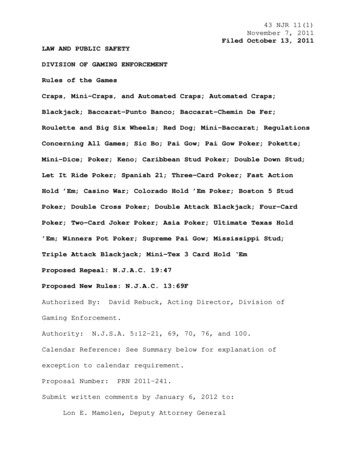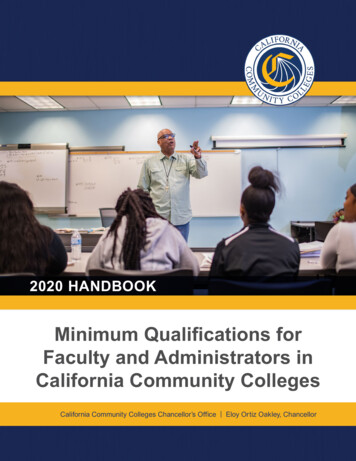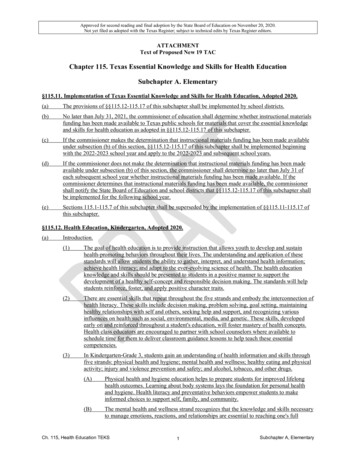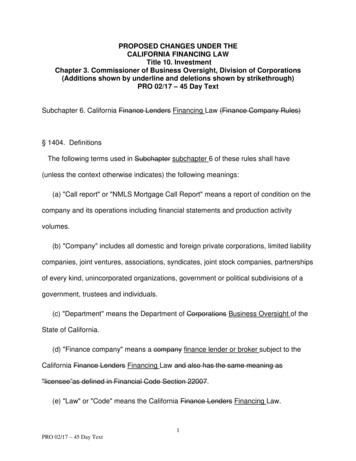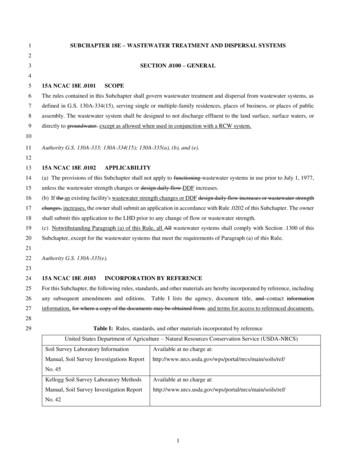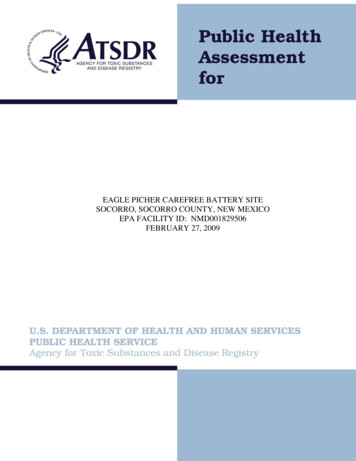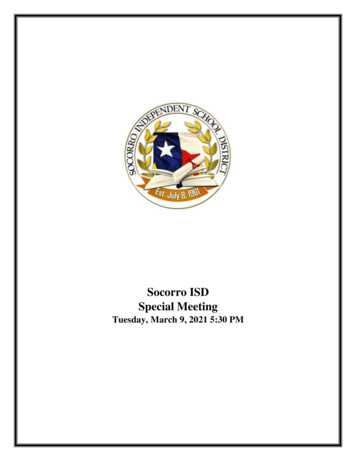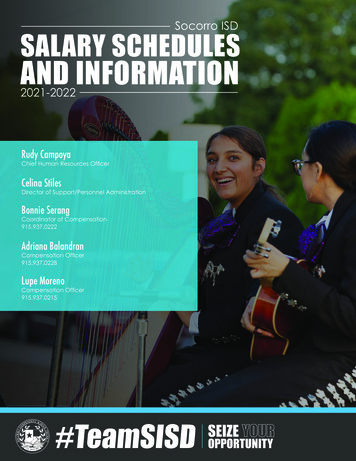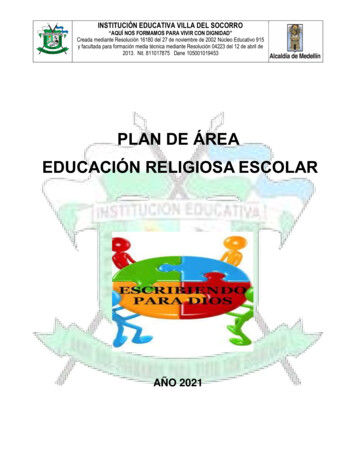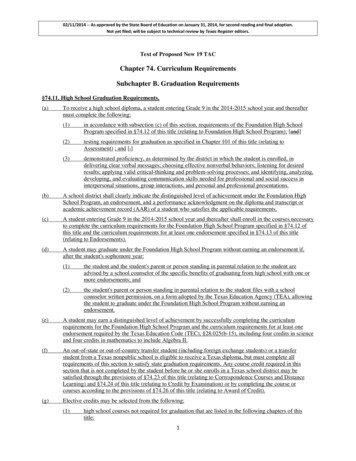
Transcription
02/11/2014 -- As approved by the State Board of Education on January 31, 2014, for second reading and final adoption.Not yet filed; will be subject to technical review by Texas Register editors.Text of Proposed New 19 TACChapter 74. Curriculum RequirementsSubchapter B. Graduation Requirements§74.11. High School Graduation Requirements.(a)To receive a high school diploma, a student entering Grade 9 in the 2014-2015 school year and thereaftermust complete the following:(1)in accordance with subsection (c) of this section, requirements of the Foundation High SchoolProgram specified in §74.12 of this title (relating to Foundation High School Program); [and](2)testing requirements for graduation as specified in Chapter 101 of this title (relating toAssessment) ; and [.](3)demonstrated proficiency, as determined by the district in which the student is enrolled, indelivering clear verbal messages; choosing effective nonverbal behaviors; listening for desiredresults; applying valid critical-thinking and problem-solving processes; and identifying, analyzing,developing, and evaluating communication skills needed for professional and social success ininterpersonal situations, group interactions, and personal and professional presentations.(b)A school district shall clearly indicate the distinguished level of achievement under the Foundation HighSchool Program, an endorsement, and a performance acknowledgment on the diploma and transcript oracademic achievement record (AAR) of a student who satisfies the applicable requirements.(c)A student entering Grade 9 in the 2014-2015 school year and thereafter shall enroll in the courses necessaryto complete the curriculum requirements for the Foundation High School Program specified in §74.12 ofthis title and the curriculum requirements for at least one endorsement specified in §74.13 of this title(relating to Endorsements).(d)A student may graduate under the Foundation High School Program without earning an endorsement if,after the student's sophomore year:(1)the student and the student's parent or person standing in parental relation to the student areadvised by a school counselor of the specific benefits of graduating from high school with one ormore endorsements; and(2)the student's parent or person standing in parental relation to the student files with a schoolcounselor written permission, on a form adopted by the Texas Education Agency (TEA), allowingthe student to graduate under the Foundation High School Program without earning anendorsement.(e)A student may earn a distinguished level of achievement by successfully completing the curriculumrequirements for the Foundation High School Program and the curriculum requirements for at least oneendorsement required by the Texas Education Code (TEC), §28.025(b-15), including four credits in scienceand four credits in mathematics to include Algebra II.(f)An out-of-state or out-of-country transfer student (including foreign exchange students) or a transferstudent from a Texas nonpublic school is eligible to receive a Texas diploma, but must complete allrequirements of this section to satisfy state graduation requirements. Any course credit required in thissection that is not completed by the student before he or she enrolls in a Texas school district may besatisfied through the provisions of §74.23 of this title (relating to Correspondence Courses and DistanceLearning) and §74.24 of this title (relating to Credit by Examination) or by completing the course orcourses according to the provisions of §74.26 of this title (relating to Award of Credit).(g)Elective credits may be selected from the following:(1)high school courses not required for graduation that are listed in the following chapters of thistitle:1
02/11/2014 -- As approved by the State Board of Education on January 31, 2014, for second reading and final adoption.Not yet filed; will be subject to technical review by Texas Register editors.(A)Chapter 110 of this title (relating to Texas Essential Knowledge and Skills for EnglishLanguage Arts and Reading);(B)Chapter 111 of this title (relating to Texas Essential Knowledge and Skills forMathematics);(C)Chapter 112 of this title (relating to Texas Essential Knowledge and Skills for Science);(D)Chapter 113 of this title (relating to Texas Essential Knowledge and Skills for SocialStudies);(E)Chapter 114 of this title (relating to Texas Essential Knowledge and Skills for LanguagesOther Than English);(F)Chapter 115 of this title (relating to Texas Essential Knowledge and Skills for HealthEducation);(G)Chapter 116 of this title (relating to Texas Essential Knowledge and Skills for PhysicalEducation);(H)Chapter 117 of this title (relating to Texas Essential Knowledge and Skills for Fine Arts);(I)Chapter 118 of this title (relating to Texas Essential Knowledge and Skills for Economicswith Emphasis on the Free Enterprise System and Its Benefits);(J)Chapter 126 of this title (relating to Texas Essential Knowledge and Skills forTechnology Applications);(K)Chapter 127 of this title (relating to Texas Essential Knowledge and Skills for CareerDevelopment); and(L)Chapter 130 of this title (relating to Texas Essential Knowledge and Skills for Career andTechnical Education);(2)state-approved innovative courses as specified in §74.27 of this title (relating to InnovativeCourses and Programs);(3)Junior Reserve Officer Training Corps (JROTC)--one to four credits; and(4)Driver Education--one-half credit.(h)College Board Advanced Placement [advanced placement] and International Baccalaureate courses may besubstituted as appropriate for required courses. A single College Board Advanced Placement [advancedplacement] or International Baccalaureate course may not count toward more than one credit required forgraduation. If a College Board Advanced Placement [advanced placement] or International Baccalaureatecourse is substituted for a required course, that course may not satisfy a requirement for an advancedcourse, but may count toward both a required course and an endorsement. College Board AdvancedPlacement [advanced placement] and International Baccalaureate courses may satisfy elective creditrequirements.(i)Courses offered for dual credit at or in conjunction with an institution of higher education that provideadvanced academic instruction beyond, or in greater depth than, the essential knowledge and skills for theequivalent high school course required for graduation may satisfy graduation requirements, includingrequirements for required courses, advanced courses, and courses for elective credit as well as requirementsfor endorsements.(j)A student may not be enrolled in a course that has a required prerequisite unless:(1)the student has successfully completed the prerequisite course(s);(2)the student has demonstrated equivalent knowledge as determined by the school district; or(3)the student was already enrolled in the course in an out-of-state, an out-of-country, or a Texasnonpublic school and transferred to a Texas public school prior to successfully completing thecourse.2
02/11/2014 -- As approved by the State Board of Education on January 31, 2014, for second reading and final adoption.Not yet filed; will be subject to technical review by Texas Register editors.(k)A district may award credit for a course a student completed without meeting the prerequisites if thestudent completed the course in an out-of-state, an out-of-country, or a Texas nonpublic school where therewas not a prerequisite.(l)Each school district shall annually report to the TEA the names of the locally developed courses, programs,institutions of higher education, and internships in which the district's students have enrolled as authorizedby the TEC, §28.002(g-1). The TEA shall make available information provided under this subsection toother districts. If a district chooses, it may submit any locally developed course for approval under §74.27of this title as an innovative course.§74.12. Foundation High School Program.(a)Credits. A student must earn at least 22 credits to complete the Foundation High School Program.(b)Core courses. A student must demonstrate proficiency in the following.(1)English language arts--four credits. Three of the credits must consist of English I, II, and III.(Students with limited English proficiency who are at the beginning or intermediate level ofEnglish language proficiency, as defined by §74.4(d) of this title (relating to English LanguageProficiency Standards), may satisfy the English I and English II graduation requirements bysuccessfully completing English I for Speakers of Other Languages and English II for Speakers ofOther Languages.) The additional credit may be selected from one full credit or a combination oftwo half credits from two different courses, subject to prerequisite requirements, from thefollowing courses:(A)English IV;(B)Independent Study in English;(C)Literary Genres;(D)Creative Writing;(E)Research and Technical Writing;(F)Humanities;(G)Public Speaking III;(H)Communication Applications, which must be combined with another half credit from theother courses listed in subparagraphs (A)-(T) of this paragraph;(I) [(H)] Oral Interpretation III;(J) [(I)] Debate III;(K)Independent Study in Speech;(L) [(J)] Independent Study in Journalism;(M) [(K)]Advanced Broadcast Journalism III;(N)Advanced Journalism: Newspaper III;(O)Advanced Journalism: Yearbook III;(P) [(L)] Advanced Placement (AP) English Literature and Composition;(Q) [(M)]International Baccalaureate (IB) Language Studies A1 Higher Level;(R) [(N)]after the successful completion of English I, II, and III, a locally developedEnglish language arts course or other activity, including an apprenticeship or traininghours needed to obtain an industry-recognized credential or certificate that is developedpursuant to the Texas Education Code (TEC), §28.002(g-1);(S) [(O)] Business English; and3
02/11/2014 -- As approved by the State Board of Education on January 31, 2014, for second reading and final adoption.Not yet filed; will be subject to technical review by Texas Register editors.(T) [(P)] a college preparatory [College Preparatory] English language arts [Language Arts] coursethat is developed pursuant to the TEC, §28.014.(2)Mathematics--three credits. Two of the credits must consist of Algebra I and Geometry.(A)(B)The additional credit may be selected from one full credit or a combination of two halfcredits from two different courses, subject to prerequisite requirements, from thefollowing courses or a credit selected from the courses listed in subparagraph (B) of thisparagraph [if taken before the additional mathematics credit required for a student to earnan endorsement] :(i)Mathematical Models with Applications;(ii)Mathematical Applications in Agriculture, Food, and Natural Resources;(iii)Digital Electronics; and(iv)Robotics Programming and Design.The additional credit may be selected from one full credit or a combination of two halfcredits from two different courses, subject to prerequisite requirements, from thefollowing courses:(i)Algebra II;(ii)Precalculus;(iii)Advanced Quantitative Reasoning;(iv)Independent Study in Mathematics;(v)Discrete Mathematics for Problem Solving;(vi)Algebraic Reasoning;(vii)Statistics;(viii) [(vi)]AP Statistics;(ix) [(vii)]AP Calculus AB;(x) [(viii)]AP Calculus BC;(xi) [(ix)]AP Computer Science;(xii) [(x)]IB Mathematical Studies Standard Level;(xiii) [(xi)]IB Mathematics Standard Level;(xiv) [(xii)]IB Mathematics Higher Level;(xv) [(xiii)]IB Further Mathematics Higher Level;(xvi) [(xiv)]Engineering Mathematics;(xvii) [(xv)]Statistics and Risk Management;(xviii) [(xvi)]Discrete Mathematics for Computer Science;(xix) [(xvii)]pursuant to the TEC, §28.025(b-5), after the successful completion ofAlgebra II, a mathematics course endorsed by an institution of higher educationas a course for which the institution would award course credit or as aprerequisite for a course for which the institution would award course credit.The Texas Education Agency (TEA) shall maintain a current list of coursesoffered under this subparagraph; and(xx) [(xviii)]after the successful completion of Algebra I and Geometry, a locallydeveloped mathematics course or other activity, including an apprenticeship or4
02/11/2014 -- As approved by the State Board of Education on January 31, 2014, for second reading and final adoption.Not yet filed; will be subject to technical review by Texas Register editors.training hours needed to obtain an industry-recognized credential or certificatethat is developed pursuant to the TEC, §28.002(g-1).(3)Science--three credits. One credit must consist of Biology, AP Biology, or IB Biology.(A)(B)One credit must be selected from the following laboratory-based courses:(i)Integrated Physics and Chemistry;(ii)Chemistry;(iii)AP Chemistry;(iv)IB Chemistry;(v)Physics;(vi)Principles of Technology;(vii)AP Physics 1: Algebra-Based; and(viii)IB Physics.The additional credit may be selected from one full credit or a combination of two halfcredits from two different courses, subject to prerequisite requirements, from thefollowing laboratory-based courses:(i)Chemistry;(ii)Physics;(iii)Aquatic Science;(iv)Astronomy;(v)Earth and Space Science;(vi)Environmental Systems;(vii)AP Biology;(viii)AP Chemistry;(ix)AP Physics 1: Algebra-Based;(x)AP Physics 2: Algebra-Based;(xi)AP Physics C;(xii)AP Environmental Science;(xiii)IB Biology;(xiv)IB Chemistry;(xv)IB Physics;(xvi)IB Environmental Systems;(xvii)Advanced Animal Science;(xviii)Advanced Plant and Soil Science;(xix)Anatomy and Physiology;(xx)Medical Microbiology;(xxi)Pathophysiology;(xxii)Food Science;5
02/11/2014 -- As approved by the State Board of Education on January 31, 2014, for second reading and final adoption.Not yet filed; will be subject to technical review by Texas Register editors.(xxiii)Forensic Science;(xxiv)Advanced Biotechnology;(xxv)Principles of Technology;(xxvi)Scientific Research and Design;(xxvii) Engineering Design and Problem Solving;(xxviii) Principles of Engineering;(C)(4)(5)(xxix)pursuant to the TEC, §28.025(b-5), after the successful completion of physics, ascience course endorsed by an institution of higher education as a course forwhich the institution would award course credit or as a prerequisite for a coursefor which the institution would award course credit. The TEA shall maintain acurrent list of courses offered under this clause; and(xxx)a locally developed science course or other activity, including an apprenticeshipor training hours needed to obtain an industry-recognized credential orcertificate that is developed pursuant to the TEC, §28.002(g-1).Credit may not be earned for both physics and Principles of Technology to satisfy sciencecredit requirements.Social studies--three credits. Two of the credits must consist of United States History StudiesSince 1877 (one credit), United States Government (one-half credit), and Economics withEmphasis on the Free Enterprise System and Its Benefits (one-half credit). The additional creditmay be selected from the following courses:(A)World History Studies;(B)World Geography Studies; and(C)Combined World History/World Geography.Languages other than English (LOTE)--two credits.(A)(B)The credits may be selected from the following:(i)any two levels in the same language; or(ii)two credits in computer programming languages selected from ComputerScience, I, II, and III .(iii)The provision relating to Computer Science I, II, and III in subsection(b)(5)(A)(ii) of this section applies to credits earned before September 1, 2016.Credits earned for Computer Science I, II, and III may not satisfy LOTE creditrequirements on or after September 1, 2016, and may not be used to complywith subsection (b)(5)(A) of this section. The provision relating to ComputerScience I, II, and III in subsection (b)(5)(A)(ii) of this section expires September1, 2017.If a student, in completing the first credit of LOTE, demonstrates that the student isunlikely to be able to complete the second credit, the student may substitute anotherappropriate course as follows:(i)Special Topics in Language and Culture; [or](ii)World History Studies or World Geography Studies for a student who is notrequired to complete both by the local district;(iii)another credit selected from Chapter 114 of this title (relating to Texas EssentialKnowledge and Skills for Languages Other Than English); or(iv)computer programming languages.6
02/11/2014 -- As approved by the State Board of Education on January 31, 2014, for second reading and final adoption.Not yet filed; will be subject to technical review by Texas Register editors.[(ii)(C)(D)(6)another credit selected from Chapter 110 of this title (relating to Texas EssentialKnowledge and Skills for English Language Arts and Reading); Chapter 111 ofthis title (relating to Texas Essential Knowledge and Skills for Mathematics);Chapter 112 of this title (relating to Texas Essential Knowledge and Skills forScience); Chapter 113 of this title (relating to Texas Essential Knowledge andSkills for Social Studies); or Chapter 114 of this title (relating to Texas EssentialKnowledge and Skills for Languages Other Than English); and computerprogramming.]The determination regarding a student's ability to complete the second credit of LOTEmust be agreed to by:(i)the teacher of the first LOTE credit course, the principal or designee, and thestudent's parent or person standing in parental relation;(ii)the student's admission, review, and dismissal (ARD) committee if the studentreceives special education services under the TEC, Chapter 29, Subchapter A; or(iii)the committee established for the student under Section 504, Rehabilitation Actof 1973 (29 United States Code, Section 794) if the student does not receivespecial education services under the TEC, Chapter 29, Subchapter A, but iscovered by the Rehabilitation Act of 1973.A student, who due to a disability, is unable to complete two credits in the same languagein a language other than English, may substitute a combination of two credits fromEnglish language arts, mathematics, science, or social studies or two credits in career andtechnical education or technology applications for the LOTE credit requirements. Thedetermination regarding a student's ability to complete the LOTE credit requirements willbe made by:(i)the student's ARD committee if the student receives special education servicesunder the TEC, Chapter 29, Subchapter A; or(ii)the committee established for the student under Section 504, Rehabilitation Actof 1973 (29 United States Code (USC), §794) if the student does not receivespecial education services under the TEC, Chapter 29, Subchapter A, but iscovered by the Rehabilitation Act of 1973.Physical education--one credit.(A)The required credit may be selected from any combination of the following one-half toone credit courses:(i)Foundations of Personal Fitness;(ii)Adventure/Outdoor Education;(iii)Aerobic Activities; and(iv)Team or Individual Sports.(B)In accordance with local district policy, the required credit may be earned throughcompletion of any Texas essential knowledge and skills-based course that meets therequirement in subparagraph (E) of this paragraph for 100 minutes of moderate tovigorous physical activity per five-day school week and that is not being used to satisfyanother specific graduation requirement.(C)In accordance with local district policy, credit for any of the courses listed insubparagraph (A) of this paragraph may be earned through participation in the followingactivities:(i)Athletics;7
02/11/2014 -- As approved by the State Board of Education on January 31, 2014, for second reading and final adoption.Not yet filed; will be subject to technical review by Texas Register editors.(D)(ii)Junior Reserve Officer Training Corps (JROTC); and(iii)appropriate private or commercially sponsored physical activity programsconducted on or off campus. The district must apply to the commissioner ofeducation for approval of such programs, which may be substituted for stategraduation credit in physical education. Such approval may be granted under thefollowing conditions.(I)Olympic-level participation and/or competition includes a minimum of15 hours per week of highly intensive, professional, supervisedtraining. The training facility, instructors, and the activities involved inthe program must be certified by the superintendent to be ofexceptional quality. Students qualifying and participating at this levelmay be dismissed from school one hour per day. Students dismissedmay not miss any class other than physical education.(II)Private or commercially sponsored physical activities include thosecertified by the superintendent to be of high quality and well supervisedby appropriately trained instructors. Student participation of at leastfive hours per week must be required. Students certified to participateat this level may not be dismissed from any part of the regular schoolday.In accordance with local district policy, up to one credit for any one of the courses listedin subparagraph (A) of this paragraph may be earned through participation in any of thefollowing activities:(i)Drill Team;(ii)Marching Band; and(iii)Cheerleading.(E)All substitution activities allowed in subparagraphs (B)-(D) of this paragraph mustinclude at least 100 minutes per five-day school week of moderate to vigorous physicalactivity.(F)Credit may not be earned more than once for any course identified in subparagraph (A) ofthis paragraph. No more than four substitution credits may be earned through anycombination of substitutions allowed in subparagraphs (B)-(D) of this paragraph.(G)A student who is unable to participate in physical activity due to disability or illness maysubstitute an academic elective credit (English language arts, mathematics, science, orsocial studies) or a course that is offered for credit as provided by the TEC, §28.002(g-1),for the physical education credit requirement. The determination regarding a student'sability to participate in physical activity will be made by:(i)the student's ARD committee if the student receives special education servicesunder the TEC, Chapter 29, Subchapter A;(ii)the committee established for the student under Section 504, Rehabilitation Actof 1973 (29 USC, §794) if the student does not receive special educationservices under the TEC, Chapter 29, Subchapter A, but is covered by theRehabilitation Act of 1973; or(iii)a committee established by the school district of persons with appropriateknowledge regarding the student if each of the committees described by clauses(i) and (ii) of this subparagraph is inapplicable. This committee shall follow thesame procedures required of an ARD or a Section 504 committee.8
02/11/2014 -- As approved by the State Board of Education on January 31, 2014, for second reading and final adoption.Not yet filed; will be subject to technical review by Texas Register editors.(7)Fine arts--one credit.(A)(B)The credit may be selected from the following courses subject to prerequisiterequirements :(i)Art, Level I, II, III, or IV;(ii)Dance, Level I, II, III, or IV;(iii)Music, Level I, II, III, or IV;(iv)Theatre, Level I, II, III, or IV;(v)Principles and Elements of Floral Design;(vi)Digital Art and Animation; and(vii)3-D Modeling and Animation.In accordance with local district policy, credit may be earned through participation in acommunity-based fine arts program not provided by the school district in which thestudent is enrolled. The district must apply to the commissioner of education for approvalof such programs, which may be substituted for state graduation credit in fine arts.Approval may be granted if the fine arts program provides instruction in the essentialknowledge and skills identified for a fine arts course as defined by Chapter 117,Subchapter C, of this title (relating to High School).(c)Elective courses--five credits. The credits must be selected from the list of courses specified in §74.11(g) ,(h), or (i) of this title (relating to High School Graduation Requirements) or from a locally developedcourse or activity developed pursuant to the TEC, §28.002 (g-1), for which a student may receive credit andthat does not satisfy a specific course requirement [which is not counted toward another graduationrequirement] .(d)Substitutions. No substitutions are allowed in the Foundation High School Program, except as specified inthis chapter.§74.13. Endorsements.(a)A student shall specify in writing an endorsement the student intends to earn upon entering Grade 9.(b)A district shall permit a student to enroll in courses under more than one endorsement before the student'sjunior year and to choose, at any time, to earn an endorsement other than the endorsement the studentpreviously indicated. This section does not entitle a student to remain enrolled to earn more than 26 credits.(c)A student must earn at least 26 credits to earn an endorsement.(d)A school district may define advanced courses and determine a coherent sequence of courses for anendorsement area, provided that prerequisites in Chapters 110-118, 126, 127, and 130 of this title arefollowed.(e)To earn an endorsement a student must demonstrate proficiency in the following.(1)The curriculum requirements for the Foundation High School Program as defined by §74.12 ofthis title (relating to Foundation High School Program).(2)A fourth [An additional] credit in mathematics that may be selected from one full credit or acombination of two half credits from two different courses, subject to prerequisite requirements,from the following courses:(A)Algebra II;(B)Precalculus;(C)Advanced Quantitative Reasoning;(D)Independent Study in Mathematics;9
02/11/2014 -- As approved by the State Board of Education on January 31, 2014, for second reading and final adoption.Not yet filed; will be subject to technical review by Texas Register editors.(E)Discrete Mathematics for Problem Solving;(F)Algebraic Reasoning;(G)Statistics;(H) [(F)]Advanced Placement (AP) Statistics;(I) [(G)] AP Calculus AB;(J) [(H)]AP Calculus BC;(K) [(I)] AP Computer Science;(L) [(J)] International Baccalaureate (IB) Mathematical Studies Standard Level;(M) [(K)]IB Mathematics Standard Level;(N) [(L)]IB Mathematics Higher Level;(O) [(M)]IB Further Mathematics Higher Level;(P) [(N)]Engineering Mathematics;(Q) [(O)]Statistics and Risk Management;(R) [(P)]Discrete Mathematics for Computer Science;(S) [(Q)]pursuant to the Texas Education Code (TEC), §28.025(b-5), after the successfulcompletion of Algebra II, a mathematics course endorsed by an institution of highereducation as a course for which the institution would award course credit or as aprerequisite for a course for which the institution would award course credit. The TexasEducation Agency (TEA) shall maintain a current list of courses offered under thissubparagraph; [and](T) [(R)]after the successful completion of Algebra I and Geometry, a locally developedmathematics course or other activity, including an apprenticeship or training hoursneeded to obtain an industry-recognized credential or certificate that is developedpursuant to the TEC, §28.002(g-1) ; and [.](U)Mathematical Models with Applications, if credit is earned prior to September 1, 2015, orSeptember 1 of a subsequent year in which either of the courses listed in subparagraph(F) or (G) of this paragraph has been developed and approved by the State Board ofEducation, whichever is later.(3)A student may complete a course listed in paragraph (2) of this subsection before or aftercompleting a course listed in §74.12(b)(2)(A) of this title.(4)The fourth mathematics credit may be a college preparatory mathematics course that is developedand offered pursuant to the TEC, §28.014.[(3)The additional mathematics credit may be selected from one full credit or a combination of twohalf credits from two different courses, subject to prerequisite requirements, from the followingcourses if taken after the third mathematics credit required under the foundation high schoolprogram:][(A)Mathematical Models with Applications;][(B)Mathematical Applications in Agriculture, Food, and Natural Resources;][(C)Digital Electronics; and][(D)Robotics Programming and Design.](5) [(4)] An additional credit in science that may be selected from one full credit or a combination of twohalf credits from two different courses, subject to prerequisite requirements, from the followingcourses:10
02/11/2014 -- As approved by the State Board of Education on January 31, 2014, for second reading and final adoption.Not yet filed; will be subject to technical review by Texas Register editors.(A)Chemistry;(B)Physics;(C)Aquatic Science;(D)Astronomy;(E)Earth and Space Science;(F)Environmental Systems;(G)AP Biology;(H)AP Chemistry;(I)AP Physics 1: Algebra-Based;(J)AP Physics 2: Algebra-Based;(K)AP Physics C;(L)AP Environmental Science;(M)IB Biology;(N)IB Chemistry;(O)IB Physics;(P)IB Environmental Systems;(Q)Advanced Animal Science;(R)Advanced Plant and Soil Science;(S)Anatomy and Physiology;(T)Medical Microbiology;(U)Pathophysiology;(V)Food Science;(W)Forensic Science;(X)Advanced Biotechnology;(Y)Principles of Technology;(Z)Scientific Research and Design;(AA)Engineering Design and Problem Solving;(BB)Principles of Engineering;(CC)pursuant to the TEC, §28.025(b-5), after the successful completion of physics, a sciencecourse endorsed by an institution of higher education as a course for which the institutionwould award course credit or as a prerequisite for a course for which the institutionwould award course credit. The TEA shall maintain a current list of courses offered underthis subparagraph;(DD)a locally developed science course or other activity, including an apprenticeship ortraining hours needed to obtain an industry-recognized credential or certificate that isdeveloped pursuant to the TEC, §28.002(g-1);(EE)pursuant to the TEC, §28.025(c-3), a stude
High School Graduation Requirements. (a) To receive a high school diploma, a student entering Grade 9 in the 2014-2015 school year and thereafter . the student's parent or person standing in parental relation to the student files with a school counselor written permission, on a form adopted by the Texas Education Agency (TEA), allowing .
